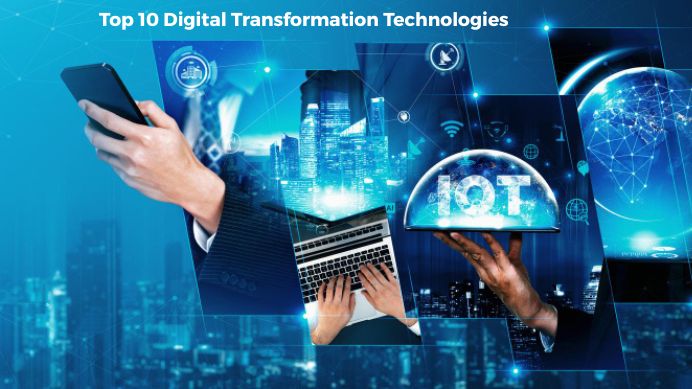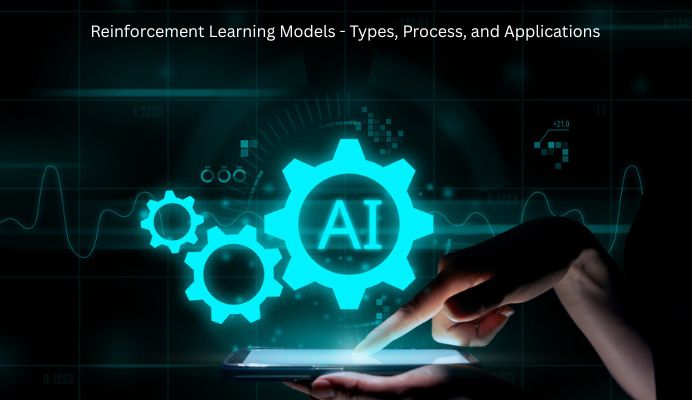
Top 10 Digital Transformation Technologies in 2025
Want to know which digital transformation technologies can revolutionize your business?
Digital transformation is rapidly reshaping the business landscape, with organizations across various industries embracing cutting-edge technologies to stay ahead in the digital age.
The pace of technological advancement is accelerating, driving significant changes in how businesses operate, engage with customers, and innovate. Understanding and leveraging the right digital transformation technologies is crucial for companies aiming to remain competitive and achieve their business goals.
In this article, we will look into the top 10 digital transformation technologies in 2025
What are digital transformation technologies?
Digital transformation technologies are tools and platforms that enable organizations to fundamentally change how they operate, deliver value, and interact with customers by integrating digital solutions across all areas of the business.
Some of the key digital transformation benefits help the shift from traditional processes to more agile, data-driven, and automated workflows.
How do digital transformation technologies work?
Digital transformation technologies function by integrating digital tools and platforms into every facet of an organization, fundamentally changing how businesses operate, deliver value, and interact with customers.
1. Assessment and strategy development
Organizations start by assessing their current state, identifying technological gaps, and defining clear objectives for transformation, such as improving efficiency, enhancing customer experience, or enabling new business models. A strategic plan is developed, aligning technology initiatives with business goals and prioritizing areas that will have the most significant impact.
2. Technology selection and integration
Businesses select appropriate digital technologies, such as cloud computing, AI, IoT, or automation, based on their specific needs and industry requirements. These technologies are integrated into existing processes or used to create entirely new workflows, often requiring updates to legacy systems and infrastructure.
3. Process redesign and optimisation
Digital transformation often involves rethinking and redesigning business processes to leverage the capabilities of new technologies. Processes are mapped out, optimized for efficiency, and automated where possible, reducing manual effort and errors.
4. Data utilisation and analytics
Digital tools enable the collection, analysis, and use of vast amounts of data, providing insights that inform decision-making, personalize customer experiences, and drive continuous improvement. Real-time analytics and dashboards help organizations monitor performance and adapt quickly to changing conditions.
Top 10 Digital Transformation Technologies in 2025
Let’s look at the key digital transformation technologies in 2025
1. Cloud computing
Cloud computing is undeniably the backbone of digital transformation. It provides organizations with the flexibility, scalability, and cost-efficiency needed to adapt to the ever-changing business environment and effective change management.
This dynamic nature allows businesses to adjust operations in response to fluctuating market conditions, ensuring they remain competitive in the digital age.
The migration to cloud platforms is more than just a trend; it’s a necessity for meeting modern operational demands and enhancing efficiency. Industries across the board are moving their operations to the cloud to accelerate their digital transformation efforts.
Integrating cloud computing into their digital transformation journey enables organizations to achieve significant cost savings, enhance digital processes, drive business transformation, and support revenue growth.
2. Artificial intelligence and machine learning
Artificial intelligence (AI) and machine learning (ML) are at the forefront of digital transformation technologies, reshaping business processes and driving innovation. Advancements in AI, such as natural language processing and reinforcement learning, are pivotal in transforming how businesses operate.
These technologies encourage a culture of innovation and enable faster decision-making, making them indispensable tools in the digital transformation toolkit.
Additionally, AI and ML support decision-making in organizations by generating predictive insights based on data analytics. These insights help businesses make smarter decisions and improve efficiency. By leveraging technology investments in AI and ML, organizations can harness the power of data to drive digital innovations and achieve their business goals.
AI and ML are transformative forces enabling organizations to automate processes, improve operational efficiency, and enhance customer experiences. Integrating these advanced technologies into the transformation process of digital transformation strategies unlocks new opportunities for growth and innovation.
3. Internet of Things(IoT) platforms
The Internet of Things (IoT) platforms are revolutionizing how businesses connect and interact with physical devices. IoT serves as a crucial link, enabling the digitization of physical products and connecting them to business systems. This seamless interaction between physical and digital systems is fundamental to successful digital transformation initiatives.
The data collected by IoT devices provides valuable insights that improve product utility and performance, leading to better innovation. IoT technology facilitates the collection of data from various departments, including manufacturing, marketing, and support, enabling faster innovation cycles and the development of new business models based on these insights. This integration of IoT platforms into business processes is a key driver of digital transformation projects.
4. Robotic Process Automation
Robotic process automation is a transformative technology that automates repetitive, rule-based tasks, thereby enhancing operational efficiency. RPA solutions can handle both simple and complex tasks, streamlining workflows and improving work accuracy and speed. By automating these tasks, organizations can achieve significant improvements in productivity and resource allocation.
One of the key benefits of RPA is its ability to ensure consistent adherence to compliance regulations across various industries. This is particularly important in sectors where regulatory compliance is critical. By reducing human error and ensuring that processes are followed accurately, RPA enhances the overall security and reliability of business operations.
5. No-code development platforms
No-code development platforms are revolutionizing software development by enabling rapid application development and deployment. These platforms empower organizations to build applications without needing complex coding skills, making them accessible to non-technical users. This democratization of software development allows employees to create customized solutions that meet specific business needs.
The use of pre-built templates and components significantly speeds up the development process, allowing businesses to develop and deploy custom applications up to 10 times faster than traditional methods.
This rapid prototyping capability enables businesses to test new ideas quickly and iterate based on feedback, fostering a culture of innovation within the organization.
6. Data analytics and Business Intelligence tools
Data analytics and business intelligence (BI) tools are critical components of successful digital transformation strategies for business leaders. These tools provide real-time and predictive analytics, enabling businesses to gain valuable insights that enhance operational efficiency and drive growth.
Leveraging these insights enables organizations to develop improved business strategies, track key performance indicators, and achieve better business outcomes.
Descriptive analytics allows businesses to review past performance and identify areas for improvement, while cognitive analytics employs AI to derive insights that traditional methods may not capture. This combination of descriptive and cognitive analytics provides a comprehensive view of business performance and opportunities for innovation.
7. Digital twins
Digital twins are digital replicas of physical systems, processes, or products that enable organizations to simulate changes and optimize processes. By creating a virtual model of a physical entity, businesses can explore various design and operational scenarios in a risk-free environment, leading to more informed decision-making.
Digital twins offer continuous monitoring of system states and interactions, providing deeper insights into product performance and enabling predictive maintenance and optimization. This continuous monitoring capability ensures that products and processes are operating at their best, reducing downtime and improving reliability.
8. Augmented Reality and Virtual Reality
Augmented Reality (AR) and Virtual Reality (VR) are digital technologies that are revolutionizing how businesses engage with customers and improve operational efficiency.
AR overlays digital images onto the real world, enhancing the surrounding environment and making interactions more engaging. VR, on the other hand, immerses users in a simulated environment through headsets or similar devices, creating unique and interactive experiences.
AR and VR are powerful tools for enhancing customer engagement, streamlining product development, and improving training processes. Integrating these advanced technologies into digital transformation strategies allows businesses to create innovative and interactive experiences that drive growth and efficiency.
9. Blockchain technology
Blockchain technology is a digital ledger that securely records transactions across multiple computers, ensuring transparency, security, and tamper-proof processes.
The primary role of blockchain is to facilitate secure and transparent transactions, contributing to greater trust and efficiency in various industries. By leveraging this technology, businesses can automate processes and enhance operational efficiency.
In the healthcare sector, blockchain is being utilized for better management of electronic medical records and improving data security. This technology ensures that patient data is securely stored and easily accessible, enhancing the overall efficiency of healthcare services. Despite the complexity of blockchain technology, its potential benefits make it a valuable investment for organizations looking to enhance their business value and digital transformation efforts.
10. Cybersecurity solutions
In the era of digital transformation, robust cybersecurity solutions are critical for protecting digital assets and ensuring data privacy. As organizations adopt new technologies and digital solutions, they must also adapt their cybersecurity strategies to handle new data access control challenges. Advanced cybersecurity solutions feature critical elements such as threat detection, identity management, and compliance monitoring to safeguard against cyber threats.
Organizations that adhere to compliance regulations are significantly less prone to experiencing data breaches, which helps maintain customer trust and confidence. The rapid evolution of digital transformation necessitates continuous adaptation and enhancement of cybersecurity measures to stay ahead of emerging threats, ultimately improving the organization’s ability to protect sensitive information.
The landscape of digital transformation is being shaped by a suite of advanced technologies. From cloud computing, AI, and IoT to RPA, low-code platforms, data analytics, digital twins, AR/VR, blockchain, and cybersecurity, each technology plays a crucial role in driving digital transformation efforts.
Moreover, Digital transformation companies like iTCart is also leveraging technologies that shape an organization from traditional to modern.






